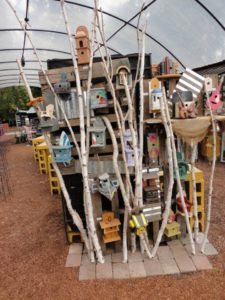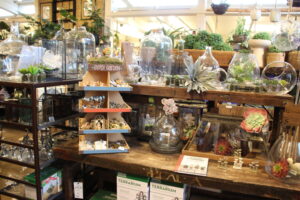
Pennsylvania Horticultural Society unveils 2024’s top 10 gardening trends
The Pennsylvania Horticultural Society (PHS) shares top trends gardeners can expect to see in 2024 based on what the organization has seen by attending conferences, exhibitions, visiting countless personal and public gardens, and conversations with professionals.
Below is the full list of PHS’s gardening trends for 2024.
1. Considering the environment as you garden
This trend includes gardening practices that put the environment first. As part of PHS’s ethos of “Gardening for the Greater Good,” here are several ways that gardening can promote environmental stewardship:
- Movements such as “Leave the Leaves” in the fall help reduce landfill waste.
- Converting two-cycle gas powered engines (blowers, lawn mowers, etc.) to battery operated machinery reduces carbon emissions.
- Creating habitats for overwintering insects by not cutting back perennials in the fall provides shelter and a source of food for insects and animals.
- “Rewilding” or converting portions of lawn into meadows using eco-friendly plantings.
- Using peat-free potting soils to help lower demand for peat harvesting. Peat bogs are vital wetland habitats for many animals, insects, and plants, and harvesting damages these important ecosystems.
- Buying brands that focus on native plants can add to backyard biodiversity and lessen the usage of resources such as water and fertilizers.
2. Growing fruit at home
Growing fruit at home has gained popularity for both those with yard space and container space. As a fun and lower maintenance alternative to growing vegetables, gardeners are driven to add some sweetness to their gardens.
3. Decorating with houseplants
Houseplants continue to dominate as a source of décor while the term “plant parent” is now a common term. Companies and retailers are focusing on education so that all levels of “plant parenting” can be accommodated through easy instructions for success.
4. Achieving ecological certifications
Home gardens are becoming popular vehicles to draw attention to the overall nature-based movement. With gardeners working hard on curating their gardens, why not garner some public recognition for your efforts? Several organizations now recognize home gardens with ecological certifications. Some of these programs include: Home Grown National Park, Monarch Watch Waystations Habitat Registration, National Wildlife Federation Wildlife Habitat Certification and Penn State Extension Service Pollinator Friendly Garden.
5. Planting pollinator-friendly gardens
Pollinator gardens provide habitat and food for native pollinating bees, wasps, moths, and butterflies, including the iconic monarch butterfly. Usage of these plants in gardens is rising — in tandem with greater awareness of the important ecological functions that pollinators provide. Creating bee habitats like “bee hotels” and leaving or stacking stems from perennials are also popular tactics gardeners are adopting to provide good overwintering habitat for pollinators.
6. Mitigating global climate change
By planting more heat and drought tolerant southern native species, gardeners can help counteract the impacts of changing weather patterns, including increases in periods of drought and much hotter summers. Strategically selecting species for drought tolerance, as well as adopting waterwise gardening practices, as well as utilizing gravel gardens, rain gardens, or swale gardens are tools that can be used to mitigate the impacts of climate change.
7. Using substitutes for boxwoods
Boxwood blight is an ongoing fungal issue for many gardeners who consider boxwoods an easy-to-care-for and durable evergreen. Boxwood blight is hard to control in the garden and since it spreads quickly, many plants are dying or being compromised. Because of this, gardeners are starting to think about alternative options to prevent potential boxwood blight.
8. Planting more grasses and sedges
Grasses and sedges continue to be popular garden plants, playing important ornamental and ecological roles in the garden. The use of these plants has been popularized by famed garden designers such as Piet Oudolf, Claudia West, Kelly Norris, Roy Diblick, Jeff Epping and many others, pushing grasses and sedges to the forefront of design instead of being just filler. While ornamental grasses have been popular for nearly three decades, their prominent usage has grown as a critical component in native plant and pollinator gardens.
9. Growing hydrangea mania
Hydrangeas will continue their dominance in the home landscaping and floral industry. Beloved for their mops of colorful, long blooming flowers in many unique shapes, hydrangeas will continue their reign in both the floral and landscaping arenas.
10. Enjoying a taste of the tropics
Tropical plants are popular in the garden for their seasonal large and luxuriant foliage. This impact in the temperate garden creates a tropical-like feeling throughout the summer and into the fall, and offers up vibrant splashes of color, bringing a taste of the tropics home.


















 Videos
Videos





